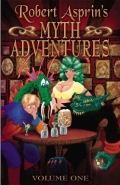
I wrote a while back about my rediscovery of the Myth books by Robert Asprin, covering the first three books in the series. I recently worked through books 4-6 in the ginormous collection, Myth Adventures, Volume I and thought I’d pause again to review this chunk of the series.
The books are still good fun, but unfortunately the shine is starting to wear off. I think the series worked best in the early days when fledgling magician Skeeve was apprenticed to dimension-traveling Aahz the demon and learning the ropes of the world that Asprin was building. Mainly by being on the run and trying to turn the tide of a lopsided fight. There’s something about that formula that just clicked with me, but it only really lasted the first couple of books.
In books 4-6 (and arguably starting in book 3), Asprin changes the formula to what would amount to a series of to a caper stories if you stripped away the dragons, wizards, devils, and other fantasy elements. Aahz, Skeeve, and the rest of the rapidly expanding cast of the books get into some kind of mess, then have to use guile, shrewdness, and smarts to get out of it. The group has a home base of operations in one dimension, but they travel to different worlds. And there’s usually some stuff about Aahz and Skeeve realizing that they have each other to depend on, as well as their cadre of friends and enemies-turned-friends. And Skeeve gets out of tight spots not only through quick wits, but by being a really nice guy who treats everyone with kindness and is generous with second chances. And so on.
On the one hand, I don’t blame Asprin for mixing it up and evolving the series. It would be tempting to just churn out more of the same instead of, for example, having the two main characters evolve from apprentice/master to equal business partners. But at the same time these subsequent books just aren’t as charming or fascinating. The different dimensions the gang traipses through seem less like worlds and more like plot devices that Asprin feels free to kick around any way he wants so that the plot moves along. One novel focuses on a world full of vampires, for example, but it’s all just kind of brushed aside to keep with the zany adventures. The imagination on display is wide, but not deep.
Still, each of the books is short, easy to read, and often entertaining. They make excellent breaks between larger reads and I plan on picking up the Volume 2 collection, which includes books 7-12.
Published by